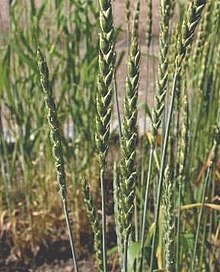Spelt

Spelt (Triticum spelta), sometimes called dinkel wheat or hulled wheat,[1] is a type of wheat. It has been cultivated since 5000 BC. It is a hexaploid wheat, which means it has six sets of chromosomes.
Spelt was an important staple food in parts of Europe from the Bronze Age to medieval times. It is still grown in Central Europe and northern Spain. Spelt originated before common wheat (Triticum aestivum), and that bread wheat is derived from spelt.
Spelt has become more popular as a type of bread in recent years.[2] Spelt costs more than modern wheats. One reason is that it is a minority product. It also needs an extra stage to remove its husks before milling (grinding).
Spelt needs less pesticide than normal wheat.[3] Nutritionally, wholemeal spelt is similar to normal wholemeal wheat, with higher protein content.[3][4][5]
People with celiac disease should avoid eating spelt.[6]
References
[change | change source]- ↑ "USDA GRIN Taxonomy". Archived from the original on 2015-10-01. Retrieved 2015-05-07.
- ↑ "Spelt grain". dovesfarm.co.uk. Archived from the original on 2015-04-23. Retrieved 2015-05-07.
- ↑ 3.0 3.1 What is spelt?
- ↑ Spelt flour recipes
- ↑ Why should I use spelt flour?
- ↑ "Treating coeliac disease". Archived from the original on 2015-05-15. Retrieved 2015-05-09.
